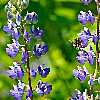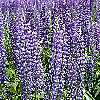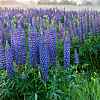Lupine WILD PERENNIAL Blue Flowers Fall Planting Hummingbirds Non-GMO 50 Seeds!
100% Pure Seed ? Non-GMO ? Fresh for this Season
PRODUCT INFORMATION
- Perennial; Stunning Color!
- North American Native Wildflower
- Prefers full sun exposure
- Lupine Seeds - Wild Perennial Lupine Seeds
- Lupinus perennis
A top choice for wildflower gardeners, Wild Perennial Lupine might get a slow start in life, often taking a full season to germinate and another to bloom, but once this beauty is established, there's no stopping it!!
*Seed scarification advised for lupine seeds (Nicking or scaring seeds with hard seed coatings before planting helps the seeds absorb water. After scarification soak seeds in water overnight before planting. This will jump-start germination and get your garden growing faster.)
Lupine (Lupinus Perennis) - Bring beauty and interest to a natural setting by sowing Lupine wild flower seeds. These flowers stand up in clusters of spikes with sweet pea-shaped blooms. While this flowering plant is highly prominent in North America, species of Lupine grow throughout the world on nearly every continent. Wild Lupine are deer resistant and quickly take root and do best in drier soils with high acidity, sand content and drainage. Perennial Lupine has beautiful violet to blue blooms throughout Spring and Summer that attract bees, butterflies, and hummingbirds with their nectar. Lupine is perfect for sowing in garden beds or at the front of a meadow.
A field of Lupine is an amazing sight, with spiky blooms of saturated indigo-blue that last from late spring to summer. Combine them with later-blooming flowers (like Shasta Daisy and Rudbeckia) for an extended season of color. Growing to be about 20-36? tall, Lupine is a great choice for the front of the meadow or garden bed. Extremely easy to grow and deer resistant, this perennial flower blooms year after year.
FAST FACTS
- Name: Wild Perennial Lupine Seeds
- Botanical Name: Lupinus perennis
- Life Cycle: Perennial
- Light Requirement: Full Sun
- Planting Season: Spring, Fall
- Plant Type: Tall wildflower with abundant stacks of purple blossoms
- Sow Lupine seeds directly outdoors in the late fall or early winter for blooms the following spring. You can sow in the spring, 4 ? 6 weeks before your average last frost date, but your flowers will not bloom until late summer. You can add a layer of mulch to help retain moisture in the soil.
- Features: Heirloom, Attracts Pollinators, Attracts Hummingbirds, Fragrant, Deer Resistant, Drought Tolerant, Cut Flower Garden, Easy to Grow & Maintain, Container Garden
- Color: Purple
- Blooms: Spring, Late Spring, Early Summer, Summer
- Plant Height: Up to 30 inches
- Plant Spacing: 12-14 inches
- Planting Depth: 1/8 inch
- Sowing Method: Direct Sow
- Cold Stratification: No
- Hardiness Zones: 3, 4, 5, 6, 7, 8, 9
- Ships: Year Round
HOW TO GROW PERENNIAL LUPINE
Once you?ve successfully grown a lupine, you?re likely to be hooked for life.
Not only is the gardener rewarded with outstanding color from spires of densely-packed flowers in a multitude of hues, but the grayish-green palmate foliage also graces the garden with fabulous texture and shape.
Some of our favorite wildflowers across the United States are lupines, from the Texas bluebonnet (L. texensis), to the eye-popping displays of violet-blue Arroyo (L.succulentus) and L. polyphyllus running up the Northern Pacific Coast. Perennial lupine, the classic old-favorite is still wildly popular, as are the impressive Russell hybrids (bred from Perennial lupines during the 20th century) which come in shades of red, white, cream, orange, pink, purple as well as in bi-colored variations.
Wherever you grow them, however you grow them, you?ll find yourself wanting to reach out and feel the texture of the densely bunched oh-so-touchable flowers ? but you?ll certainly have to wave away a host of pollinators first!
When & Where to Plant Lupine
Choose a sunny site with average, well-draining soil. Lupines are legumes and can improve a soil?s fertility over time.
Light: Full sun is preferred. Lupine can grow in part shade, but flowering will be lessened.
Soil: Lupine needs well-draining soil above all else. It prefers soil on the acid side and will not tolerate high levels of alkalinity or water-logged conditions. Russell hybrids and L. polyphyllus have more tolerance for moist conditions than many other species, but none are lovers of high heat or humidity.
Lupines are deep rooted and do not spread except through re-seeding. Seeds will not come true to the original variety planted, but will eventually revert to blue-violet and white.
Planting: The most important thing to note before planting Lupines, is that they are available as both annuals and perennials. While Lupine seeds may yield both annual (life cycle complete in one growing season) and perennial (long-lived, coming back each spring) varieties, potted Lupine plants are typically perennial cultivars.
For seeds: Lupine seeds can be planted in very early spring, but tend to do better if planted in late spring and allowed to overwinter, blooming in the following spring like foxgloves. They have a very tough seed coat, and it?s a good idea to either soak seeds for 24-48 hours, or roughen them between two sheets of sandpaper before planting.
Cover lightly with soil (1/8?) and tamp down the seeds well ? making sure they make good soil to seed contact. Water in, and if the weather is dry, water lightly until germination which can take up to 10 days
Free shipping on all orders in the USA.
Our amazing support team is here to help. Text us at 678 316 0940 and get an instant response
Your Payment is Secure and So is your Purchase. Simply return it within 30 days for an exchange.
Grab a hosting plan for that small business or personal website. Fast Setup, great speeds, low prices. Managed Hosting Too.Text us at 678 316 0940














